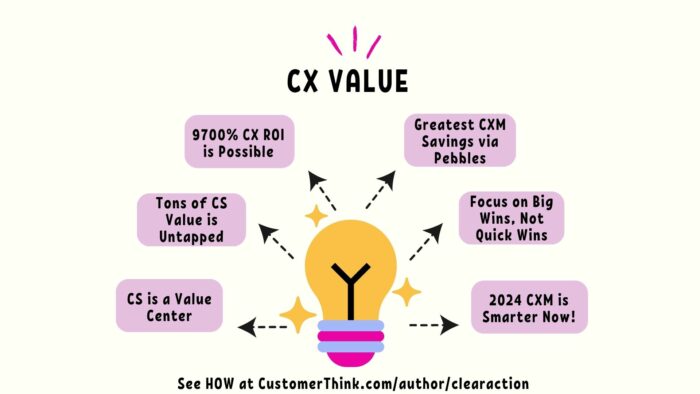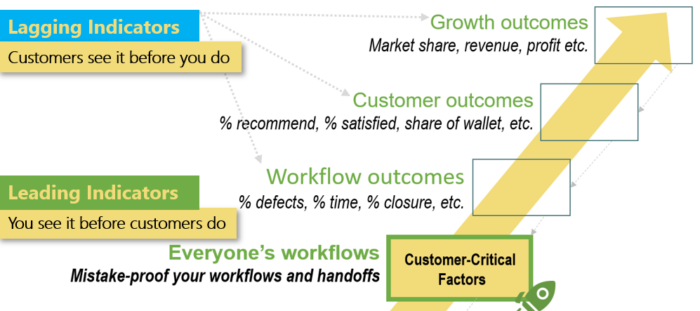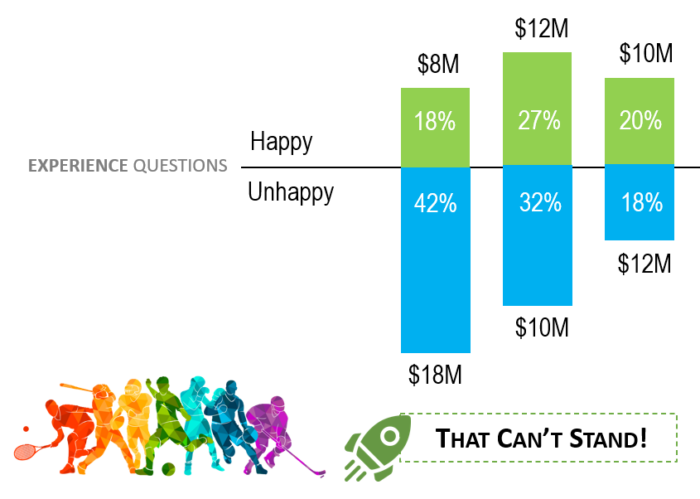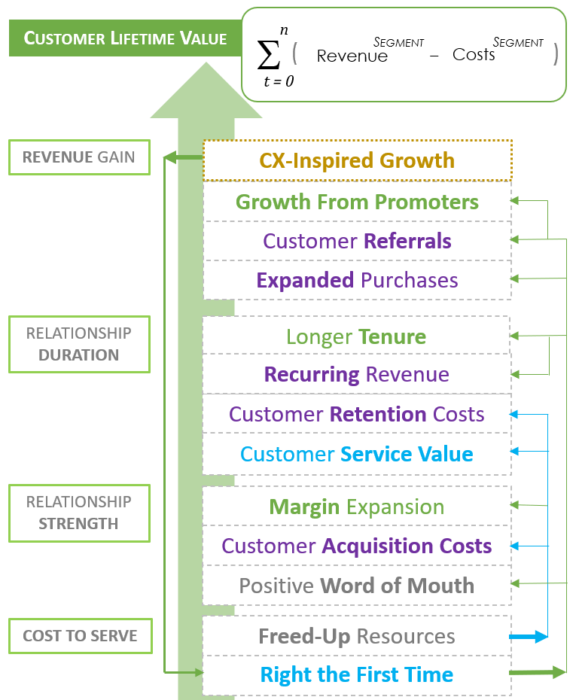CX Metrics are a big part of new CX wisdom for 2024. In the past year, at least 24 new discoveries were made in the immature field of Customer Experience Management (CXM). As I write and talk about CX (Customer Experience), CS (Customer Service and Customer Success), and CXM, I continually realize there is still much to learn about it! That’s kind of surprising when you consider that my CX career formally started as Voice of the Customer Manager in 1992. I’ve been learning ever since, and I hope you and your executives will stay curious about it, too. Curiosity is the foremost factor of customer-centric culture.
The 5 Customer Experience Metrics discoveries below (part 2) are a continuation from the 4 Customer Value discoveries published last week (part 1). This 4-part article series will also cover (3) Customer Experience + Employee Experience and (4) Customer Experience Strategy for 24 ways CXM is smarter in 2024.
CX Metrics
5. NPS is not your primary key performance indicator (KPI).
Since you can’t see NPS or financials until customers have experienced your performance, this means “the train has left the station” by the time you can report NPS. Instead, focus on what’s happening “while the train is in the station”. Make your top CX KPI how you’re improving poor experiences discovered through customer insights.
As shown in the diagram above, NPS (survey results) is a lagging indicator of your CX performance. Sure, NPS indicates what customers are inclined to do in the future, but that’s out of your control, and you don’t know whether they’ve done it until they do it. So NPS cannot be a true and controllable leading indicator of financial growth.
The best primary use of NPS (and similar indexes like CSAT, Effort Score, Health Score, etc.) is statistical correlation with other customer experience questions on your survey. Correlation analysis identifies “key drivers of loyalty”: your top priorities for improvements. This is extremely important to CX ROI, because “quick wins” or even large efforts outside these top priorities will not yield as much return on investment as the key drivers will yield.
When you identify key drivers, your next step is to follow the 80/20 rule with a bar chart of customer comments or incidents for to each driver. For each Vital Few Issue, a “5 Why’s” exercise reveals your top priority action plan. Then, decide how you will monitor the mistake-proofing of the 5th why. What you monitor is called a Customer-Critical Factor.

Customer-Critical Factors are your top CX KPI. They’re the true and controllable leading indicator of NPS and financials. They show what you’re doing that customers will soon experience.
The graphic above shows 8 examples of Customer-Critical Factors that (a) saved a lot of money, time, and opportunities for my company and all of our customers, (b) endeared us to our customers, which strengthened relationships and turned around potential churn, (c) allowed us to reallocate prior value-rescuing resources to new value-creating opportunities, and therefore, (d) grew our revenue much higher and more sustainably than we could have achieved through traditional revenue growth approaches.
6. CX data informs status, while CX patterns inspire action.
To capture managers’ full attention, continually discover and report patterns like “When X happens, then Y is 3 times more likely”. for Patterns stimulate managers’ creativity for value-creation. You rely on them to rise above the status quo because competitors and circumstances are constantly evolving. Stay current, in-tune, differentiated, and preferred by always inspiring action. Without significant action underway across your whole firm, you cannot generate sustainably impressive CX ROI.
7. Percentages motivate action.
When you report percentages and money associated with customers’ top issues and opportunities, this gives managers a sense of how much of their business is at-risk or at-opportunity. It can shift managers out of tolerating mediocrity, making the status quo unacceptable. Aim for all your reports to motivate this response from managers: “That can’t stand! How can I do something about this [gap or opportunity]?”.
8. 24 CX ROI metrics drive financial ratios.
This diagram shows which customer experience ROI metrics contribute to these financial ratios: Earnings Per Share, Cumulative Average Growth Rate, Return on Assets, Current Ratio, and Operating Margin Ratio.
A) Earnings per Share: customer lifetime value. The following contribute to Lifetime Value.
B) Cumulative Average Growth Rate: revenue gains via CX-inspired growth, along with growth from promoters (expanded purchases plus customer referrals).
C) Return on Assets: relationship duration via longer tenure (recurring revenue plus customer retention, fueled in large part by customer service value).
D) Current Ratio: relationship strength via margin expansion (by reducing acquisition costs and increasing positive word of mouth) and sales velocity (by reducing both sales cycle time and negative word of mouth).
E) Operating Margin Ratio: cost to serve via freed-up resources, freed-up customers, lower risks, and less stress (all fueled by right-the-first-time and stopping prevalent issues, which are influenced by CX-inspired performance, efficiencies, and strategies.
9. 4 gold CX Leader metrics drive 20 growth metrics.
Like most goals in life, you’ll achieve far more by focusing on fundamentals rather than the end result itself. For instance, physical fitness is not about numbers on a scale, but rather, it’s about well-balanced nutrition, muscle tone, moderation, and stress management.
Similarly, customer experience growth metrics are healthier when you focus on 4 fundamentals:
There are 4 success factors for each of these 4 gold CX Leader metrics:
These 4 fundamental CX Leader metrics have a positive domino-effect on customers’ experience matching their expectations, and then customers’ ratings and engagement, and in turn, your financial performance. When your focus is on the fundamentals that lead to your goal, then you are driving a true leading indicator of strength in CX and financials.
10. Maximum lifetime value is the ultimate aim of your CXM team.
Goals like NPS or Net Recurring Revenue imply career success by hitting a quota, by any means or costs. That’s inside-out thinking. It’s in investors’ and customers’ and employees’ best interest when you minimize waste while maximizing growth.
Furthermore, NPS is essentially a Marketing metric since that department is responsible for generating social media recommendations, customer references, and new customer leads. Likewise, Net Recurring Revenue is essentially a Sales metric since that department is responsible for generating revenue. Do not confuse Marketing, Sales, Customer Success, or Customer Service with the CXM team’s primary purpose: customer-aligned business.
Customer lifetime value is the discipline for balancing revenue, costs, short-term, long-term, and relationship strength. When you maximize lifetime value, you’re also maximizing your budgets, return on assets, and earnings per share.

Conclusion — Part 2
These 5 Customer Experience Metrics concepts are powerful!
Imagine how things will be better when every company adopts these practices:
- NPS can regain universally revered status by redirecting compensation and management focus to Customer-Critical Factors as the leading indicator of NPS and financial growth.
- Customers will see substantial improvements as managers improve Customer-Critical Factors.
- Boards, investors, and senior leadership teams will gain deep appreciation for CXM’s contributions to financial ratios.
- CX Leaders will elevate their role to driving CX-inspired growth, strategies, performance, and efficiencies. This allows CS Leaders to report directly to or dotted line to CX Leaders, whose purpose is customer-aligned business (1-to-1 ratio between your value proposition and what customers experience).
- 20 CX ROI metrics will grow significantly higher than we’ve seen in the past, due to focus on CX-inspired growth, strategies, performance, and efficiencies.
- More departments will engage in customer experience improvement as it becomes crystal clear to them how much waste is represented by poor experiences they’re directly or indirectly causing.
- Innovation in all aspects of your business will increase as managers are inspired by CX patterns.
- Investors will be enriched as you aim to maximize customer lifetime value.
This is Part 2 of a 4-article series: 2024 CX is Smarter for:
- Customer Experience Value

- Customer Experience Metrics
- Customer Experience + Employee Experience
- Customer Experience Strategy
This article is an expanded revision of the original LinkedIn article: “23 Ways CXM is Smarter Now (ICYMI)“.









